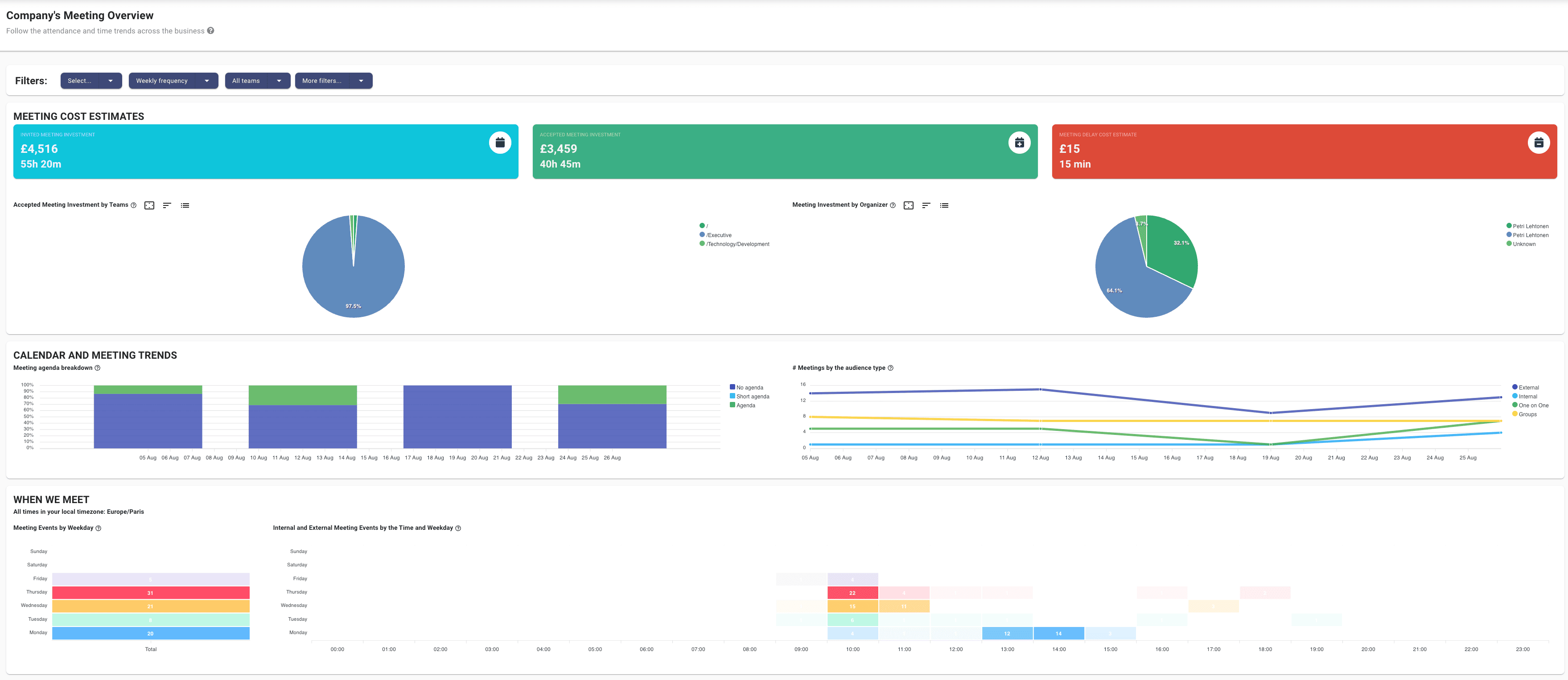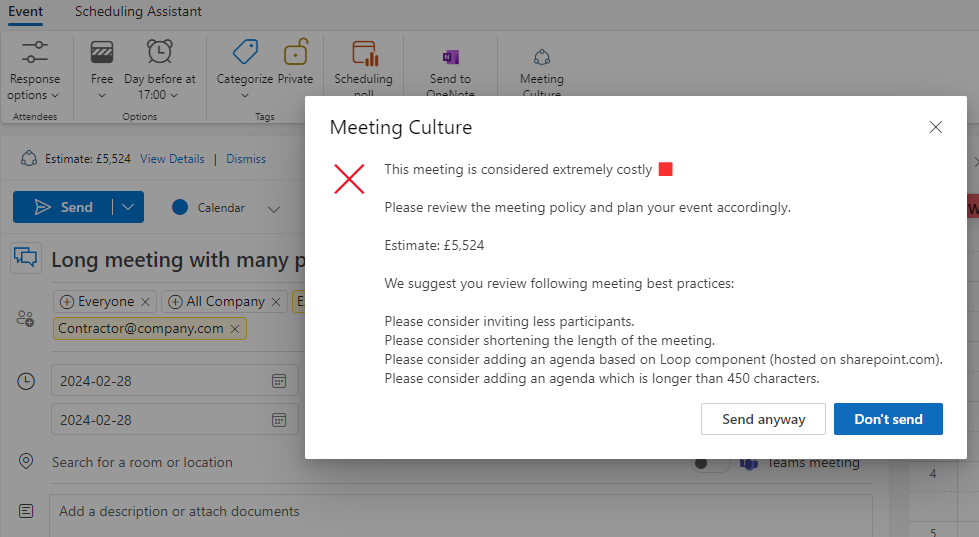For many knowledge workers, the calendar doesn’t just reflect their work, it is their work. Strategy sessions, 1:1s, standups, reviews, and cross-functional syncs now occupy the bulk of an average workweek. And yet, despite this shift, the systems we use to schedule and manage these meetings remain shockingly passive. Leaders are beginning to ask a deeper question: What is all this meeting time actually producing?
While tools like Google Calendar help us coordinate availability, they offer little visibility into the bigger picture. There’s no signal when collaboration time exceeds healthy limits, no data to evaluate meeting efficiency, and no clear view into how team bandwidth is being spent. In this context, calendar data is one of the most overlooked sources of operational insight, hiding in plain sight, yet rarely analyzed with intent.
This is where Flowtrace’s Google Calendar analytics come in, not as another scheduling layer, but as a strategic intelligence tool for leadership. Flowtrace turns everyday calendar metadata into actionable insights: surfacing patterns, diagnosing inefficiencies, and revealing where time is being consumed versus where it creates value.

The Hidden Cost of Unmeasured Meetings
Unproductive meetings are silently eating into the workweek, studies show that up to 30% of total work hours are consumed by meetings that employees deem unnecessary or ineffective. For organizations, this translates into a massive loss of time, focus, and financial resources. According to research by Harvard Business Review, executives spend an average of 23 hours per week in meetings, and nearly 71% of those meetings are considered unproductive.
Despite these numbers, many companies still operate in the dark when it comes to how time is spent in collaboration. Without clear visibility into calendar behaviors, such as meeting volume, length, frequency, and participant overlap, leadership lacks a critical feedback loop. There’s no way to know what’s working, what’s not, or how collaboration time can be optimized.
And the costs aren’t just time-related. Overbooked calendars lead to context-switching, reduced deep work, employee burnout, and decreased morale. When meetings go unchecked, they create an invisible tax on productivity and wellbeing. Relying on gut instinct or anecdotal feedback to fix this problem isn’t enough, it takes real data to build healthier, more effective meeting cultures.
Turning Calendar Activity Into Strategic Metrics

Most scheduling tools show you what’s on the calendar. Flowtrace shows you what it means for your business.
By leveraging Google Calendar analytics, Flowtrace transforms raw scheduling data into actionable, strategic insights. This enables leaders to move beyond surface-level visibility and deeply understand the hidden dynamics of collaboration time, something traditional calendar tools simply don’t deliver.
With a powerful layer of intelligence built on top of Google Calendar metadata, Flowtrace uncovers key patterns in how teams collaborate and how time is really spent. Instead of relying on guesswork or anecdotal reports, leaders get clear signals to drive better decisions and healthier team practices.
Here are the core factors Flowtrace identifies:
- Total Meeting Load: Track how meeting volume and duration evolve over time, both at the team level and across the entire organization. Spot overload before it becomes burnout.
- Collaboration Cost in Monetary Terms: Translate meeting time into financial cost based on attendee compensation, giving every meeting a measurable impact on your bottom line.
- Recurring Meeting Sprawl: Uncover recurring meetings that take up excessive time with limited ROI, and make data-backed decisions about which ones to keep, change, or cut.
- Focus Time vs. Fragmentation: Analyze how fragmented schedules affect deep work, and which teams struggle the most with context switching due to poor calendar hygiene.
- Cross-Functional Collaboration Density: Visualize how departments interact and identify whether collaboration is balanced, siloed, or overextended.
Flowtrace turns Google Calendar analytics into strategic metrics, giving leaders the insight they need to manage collaboration like any other business resource. It's not just about what's on the calendar, it's about making every hour count.
Diagnosing Meeting Culture Across Teams

Leaders often hear the same complaint across departments: “We’re stuck in too many meetings.” But without data, it’s hard to separate the symptom from the root cause, or know where to take action.
That’s where Flowtrace steps in. By harnessing Google Calendar analytics, Flowtrace gives organizations a clear window into how time is spent and where meeting culture is breaking down. Instead of reacting to vague frustrations, leaders can diagnose specific problem areas with precision.
Flowtrace enables:
- Spotting Teams with Chronic Overload: Identify groups consistently buried in meetings or lacking focus time, signs of poor time hygiene and unsustainable collaboration patterns.
- Uncovering Ineffective Recurring Meetings: Detect low-engagement recurring sessions that drain time but deliver little value, and arm leaders with data to restructure or eliminate them.
- Revealing Patterns That Block Strategic Work: Pinpoint calendar behaviors, like constant context switching or zero focus blocks, that prevent meaningful, high-impact work from happening.
These insights are powered by Google Calendar analytics, turning calendar metadata into evidence-backed signals. This gives leaders a foundation for honest, data-driven conversations about how time is really being used, moving beyond anecdotal complaints and gut instinct.
Using Calendar Insights to Drive Operational Change

Most organizations treat calendar management as a personal productivity issue, but in reality, it’s an operational challenge that affects company-wide performance. Flowtrace turns Google Calendar analytics into a powerful lever for change, giving leadership the visibility and insight to evolve not just individual schedules, but entire ways of working.
Flowtrace insights have driven strategic actions like:
- Redesigning Meeting Policies: Use real calendar behavior data to create meeting policies that reflect how people actually work, not just how they’re supposed to.
- Reallocating Leadership Time: Spot where executive calendars are overloaded with low-leverage meetings and shift that time toward strategic priorities.
- Removing Legacy Recurring Meetings: Identify standing meetings that no longer serve a purpose and confidently sunset them, freeing up hours across the org.
- Implementing No-Meeting Blocks or Async-First Norms: Use data to support company-wide focus time, async collaboration, or meeting-free days, backed by evidence, not opinion.
Building a Feedback Loop Between Data and Culture

Insights alone don’t change meeting culture, habits do. Flowtrace closes the loop between data and behavior by embedding intelligence directly into the way teams work. With Google Calendar analytics at its core, Flowtrace doesn’t just surface problems, it helps build better habits, sustainably.
Here’s how Flowtrace creates a feedback loop that drives cultural change:
- Real-Time Prompts in the Calendar: Gentle nudges encourage meeting hygiene, like adding agendas, limiting durations, and ensuring only necessary attendees are invited, right inside Google Calendar.
- Analytics That Track Progress Over Time: Teams and leaders can see how their meeting practices evolve, celebrate improvements, and stay accountable to healthier norms.
- Alignment with OKRs: Tie calendar efficiency and collaboration quality directly to key results, reinforcing that how teams spend time is just as critical as what they deliver.
This loop turns Google Calendar analytics into more than just metrics, it becomes a behavioral engine. As teams respond to prompts and see their metrics improve, a culture of self-correction emerges. No micromanagement. No top-down mandates. Just smarter collaboration, built into the rhythm of work.
Drive Meeting Performance with Analytics
Time is the most expensive and often the least measured resource in any organization. Yet, it’s where your strategy, culture, and execution all play out, day after day.
Flowtrace transforms Google Calendar analytics into a strategic lens for leadership. It gives you the clarity to see how collaboration really happens, where time is being wasted, and how meeting culture is shaping your teams’ performance. This isn’t just about scheduling, it’s about visibility, accountability, and continuous improvement.
It’s time to rethink the calendar. Not as a passive planning tool, but as an active diagnostic system for organizational effectiveness. When you manage time with the same rigor as budget or headcount, you unlock new levels of focus, alignment, and impact.
